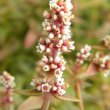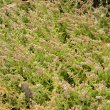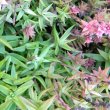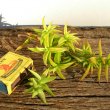| Botanical Name |
Crassula lanceolata subsp. lanceolata |
| Family |
Crassulaceae - The crassula family. |
| Pronunciation |
KRASS-yoo-la lan-see-oh-LAY-tuh |
| Common Name(s) |
|
| Plant Group |
- Ground Cover A plant with a low-growing, spreading habit, grown specifically to cover the ground.
- Succulent A plant having fleshy stems or leaves often adapted to dry conditions.
|
| Plant Size |
- Very Small
| Tree | 3m to 4m |
| Shrub | 25cm to 50cm |
| Perennial/ground cover | Up to 10cm |
| Bulb | 10cm to 20cm |
| Succulent | Up to 5cm |
|
| Position |
- Sun The area is in full sun for all or most of the day, all year round.
|
| General Information |
- Drought Tolerance: High The plant is well adapted to arid conditions; it can survive long periods of drought and high temperatures without extra water.
- Evergreen Plants that have leaves all year round.
- Frost: Half-hardy The plant is able to survive low temperatures and some frost but requires protection against severe frost.
- Water Wise Plant species originating from low rainfall regions that require less water to survive and thrive than other plant species.
|
| Specific Information |
This is a very useful ground cover for sunny, dry areas. Avoid randomly dropping leaves and stems as they will grow wherever they have been dropped.
|
| Ad Break |
|
| Flowers |
| Description |
Dense mass of tiny, star-shaped flowers, on short stems
|
| Season |
- Summer to Autumn Plants will seldom bloom for the entire season as given in the list, but should flower during a period within these parameters.
|
| Colour |
|
| Growth Rate |
- Very Fast Specifying growth rate can be very misleading as there is considerable variation of growth rate depending on type and species of plant, available water, supplementary feeding, mulching and general care, as well as the plants suitability and adaptability to the garden environment.
|
| Plant Uses |
- Ground Cover Low-lying plants that spread fast, require minimal maintenance, and cover large expanses or bare areas between bulbs or shrubs. They provide protection from erosion and drought and improve the visual appearance of the garden.
- Mass Planting Plants useful for filling a large area with just one or a few kinds of plants spaced close together. Creates a bold, dramatic effect and to reduces maintenance.
- Pioneer for new gardens A very fast growing plant, able to withstand hardship, that can be used to populate land that has recently been cleared of natural vegetation. These plants pave the way for slower-growing species by adding nutrients to the soil and creating leaf litter.
- Retaining Walls Shallow rooted plants for cascading over dry stone walls or planting in hollow spots in retaining blocks.
- Rock Garden An area constructed of larger rocks, arranged naturally, to emphasise the use of stones as a main element. Generally plants used do not need a lot of care.
- Stabilize Banks Plant is used to prevent soil erosion because their roots will form a mat that stabilizes the soil and keeps it from washing away in heavy rains.
- Wild Garden An indigenous garden planted for the benefit of wildlife and birds. Provides food, water, a variety of mini-biomes and no poisonous chemicals are used.
|
| Distribution and Habitat |
|
| Planting Suggestions |
Do not over-water this crassula if you wish to keep the red colour of the leaves. At the end of flowering, cut it very low (I use hedging shears) or even remove the old plants. Strip some of the foliage from the stems and spread the leaves and bits of plant over the area you wish to cover. Sprinkle a very little compost or fine mulch over the leaves and moisten. The plants will re-generate in a short space of time.
|
| Medicinal Uses |
|
| Ad Break |
|









Comments
Crassula capitella maybe?
Can't see too well from the photo, but looks like it might be Crassula capitella?
Just throwing my guess out there.
I thought so too at first,
I thought so too at first, but capitella grows quite large in comparison. The leaves of this species remain very small (10-15mm) and the plants have a rather loose growth structure.
Crassula lanceolata, maybe?
http://www.flickr.com/photos/crassula/5559959111/
Yes, you're right.
I have finally found an image on Flickr.com. It is Crassula lanceolata subsp. lanceolata. Thanks for the lead.
Discuss this plant
Share knowledge, ask a question or give an experience.